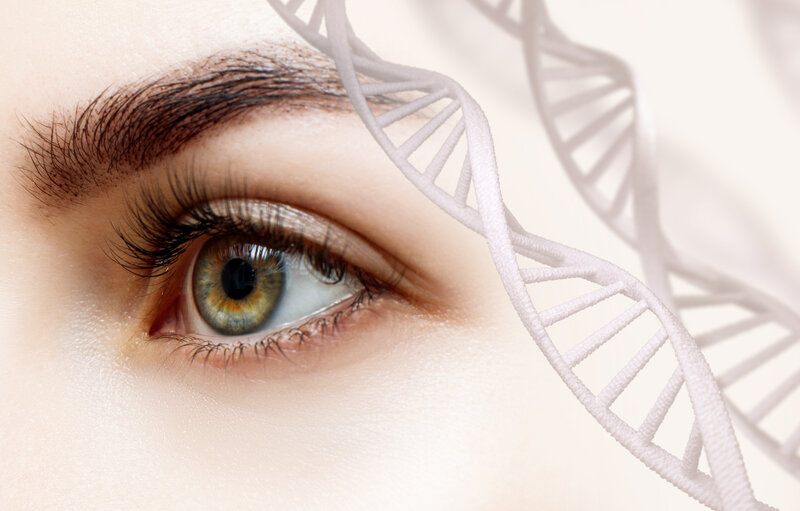Posted by: Atlantic Eye Institute in Education

An article posted in the Review of Optometry begins with the title, Genetics in Eye Care: DNA Leads the Way. And that’s so true. Our DNA is like a life’s script already outlining our physical plots and all of the potential adversaries we may meet along the way.
That said, heredity isn’t the whole story. It’s more like a script played out by actors who prefer a little improvisation along the way.
How Genetics Impact Eye Health
Barring eye trauma or unforeseen accidents or acute illnesses, genetics are the leading cause of eye disease. Almost all of the most common causes of eye disease or vision loss are traced back to genetics. Even things like being nearsighted/farsighted or having astigmatism are linked to genetics.
So, if your biological parents or grandparents had an eye disease, the odds are your risks of developing the same disease is higher than someone whose family medical history is free of the diagnosis.
Common Eye Diseases Linked To Genetics
The following are some of the most common eye diseases that almost always have a root in genetics. That said, keep in mind that genetics isn’t everything. Remember we stated that genes are like the script, but improvisation can alter the outcome of the play? Your lifestyle choices significantly impact physical health – including eye health.
So the role of genetics in eye health is largely affected by what you eat, how much you exercise, your ability to manage stress, getting a good night’s sleep, and other healthy lifestyle choices. Taking care of your body can prevent the following eye diseases or diminish their impact on vision loss and quality of life.
Glaucoma
In addition to being one of the leading causes of blindness, and permanent retinal damage, glaucoma is largely a disease of genetics. Those with a family history of glaucoma are nine times more likely to be diagnosed with it themselves.
Glaucoma is a “silent creeper” of vision loss, and most people don’t experience symptoms until the damage is already done. Annual eye exams are the only way to detect and treat glaucoma early on.
Cataracts
Research shows that more than half of those who have cataracts (58%) have a family history of cataract development. The other 48% likely suffered eye trauma or damage due to environmental factors (like excess sun exposure). Fortunately, cataract surgery is a safe and effective treatment for healthy patients.
Diabetic retinopathy
Research shows that genetics are 25% of the equation when it comes to both developing diabetic retinopathy and the rate of its progression. This is because one’s risk of developing diabetes is also genetically linked. Your proactive diet and exercise habits can almost eliminate this risk factor (more on that below).
Age-related macular degeneration
Like glaucoma, there is no permanent treatment for age-related macular degeneration (AMD). Those with a family history of AMD are four times more likely to develop AMD, and one in every five people with AMD has a sibling or parent who also has it.
Lazy eye or crossed eyes
Having a lazy eye (amblyopia) or crossed eyes (strabismus). Fortunately, both are easily diagnosed – and corrected – during the toddler and early childhood years. However, once the eyes mature, it’s harder to correct the issue. The idea is to strengthen the weaker eye or eye muscles before a child enters school.
Color blindness
The ability to perceive colors is also inherited. This condition is inherited through the mother’s genes (maternal inheritance). If a woman carries the gene for color blindness, her son(s) have a 50% chance of being color blind, and her daughters have a 50% chance of carrying the gene. If a mother carrying the gene is color blind and her husband is color blind, then both daughters and sons have a 50% chance of being color blind. This is why only about 1 in 200 women are color blind.
However, a form of color blindness, called color vision deficiency, is not inherited. Color vision deficiency results from secondary conditions, such as diabetic retinopathy, alcoholism, Parkinson’s disease, glaucoma, AMD, or medication side effect.
Lifestyle Is Equally Essential For Supporting Eye Health
Some of the conditions listed above – such as near/farsightedness, lazy eyes, crossed eyes, and inherited colorblindness – have nothing to do with lifestyle. However, healthy lifestyle choices can improve, minimize, and support others.
For example, eating a healthy diet, exercising regularly, and managing your weight can prevent or significantly diminish your chances of developing type 2 diabetes, which also minimizes or eliminates the risk of developing diabetic retinopathy. Studies also show that diet and lifestyle play a large role in the onset or severity of AMD.
Atlantic Eye Insitute Cares About The Whole Patient
This is one of the reasons the optometrists and ophthalmologists at Atlantic Eye Institute care so much about our patients’ health history. Your genetics, lifestyle, and medical history directly impact your eye and vision health. The more we know, the more we can do to minimize risks and proactive treat eye diseases before they worsen.
Are you interested in working with eye doctors that pay attention to the role of genetics in eye health? Schedule an exam with Atlantic Eye Insitute today.



